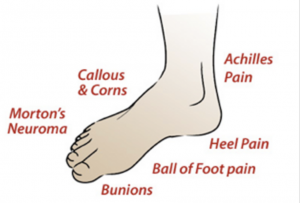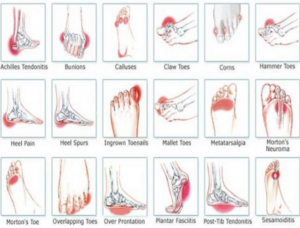Common Causes of Foot & Ankle Pain
Whether you’re a career woman who wears high-heeled shoes every day, an avid athlete who plays sports all year round, or you just have foot issues, odds are you will need foot pain treatment at some point in your life. Painful feet can strike men and women, both young and old.
This pain can be very severe, causes range from bunions, trapped and inflamed nerves (Morton’s Neuroma) to injury and arthritis.
Problems with the feet can cause pain in the hip, knee and spine as your walking pattern (gait) is thrown out of sync.
Treatments for these problems range from basic painkillers and special custom made orthotics to support your feet, to ultra-modern surgical techniques to cure the pain


How are the causes of Foot and Ankle Pain diagnosed?
First and foremost the most important thing is that you are seen and assessed by a doctor who is a recognised expert in foot and ankle problems. This is because this is a complex area and reaching the correct diagnosis is so important to planning the correct treatment. Without correct treatment early on, the chances of a full recovery with pain free movement and avoiding future complications such as arthritis are greatly reduced.
So the first thing you can expect is your doctor to take a detailed story or “history” of what happened during the injury and what your symptoms have been since then. He or she will then examine you thoroughly to see if there is any evidence of cartilage or ligament damage. An experienced doctor will frequently be able to give you a “provisional” or likely diagnosis there and then.
Although your doctor will have a pretty good idea what is the problem with your foot or ankle, he or she will need to arrange further tests to confirm the diagnosis. The tests likely to be arranged are:
An X-Ray
An X-ray is a simple test and often used to look at the foot and ankle for signs of arthritis, bunions and fractures.
MRI Scan
Magnetic Resonance Scanning or MRI is used in to examine and look at the soft tissues around the foot and ankle. This is especially useful in patients with tendon and ligament tears or pain from tendonitis or neuromas (painful inflamed tendon and nerve that may also have a lump within it). It is also very good at looking at the cartilage within the area.
Ultrasound Scan
Ultrasound is another useful way of diagnosing tendon, ligament and nerve disorders. Ultrasound guided injections are often used to treat conditions such as Morton’s Neuroma, which is a painful condition when the nerves between the long bones of the forefoot becomes swollen and tender due to repetitive crush injury due to tight footwear.
We have a specialist team of dedicated musculo-skeletal radiologists trained in interventional techniques for treating a wide range of lower leg, heel, foot & ankle pain.
Options for Foot & Ankle Pain
If you’re experiencing chronic foot pain it’s important to seek treatment as soon as possible so the problem doesn’t lead to something more severe. Treatment depends on the type of foot problem and severity of the condition causing the pain. Before deciding how to treat your foot pain, a foot and ankle specialist will full assess all the issues causing you pain including when the pain started, how often it occurs, what you’re doing when you experience the foot pain, and your medical history.
Non-Surgical Treatments for Foot & Ankle Pain
- Anti-inflammatory medications
- Over the counter or prescription pain medications
- Stretching exercises
- Custom Orthotics
- Physical therapy
- Fitting for proper shoe wear
- Injections for targeting and treating the source of pain
Surrey Orthopaedic Clinic Foot & Ankle Specialists:





